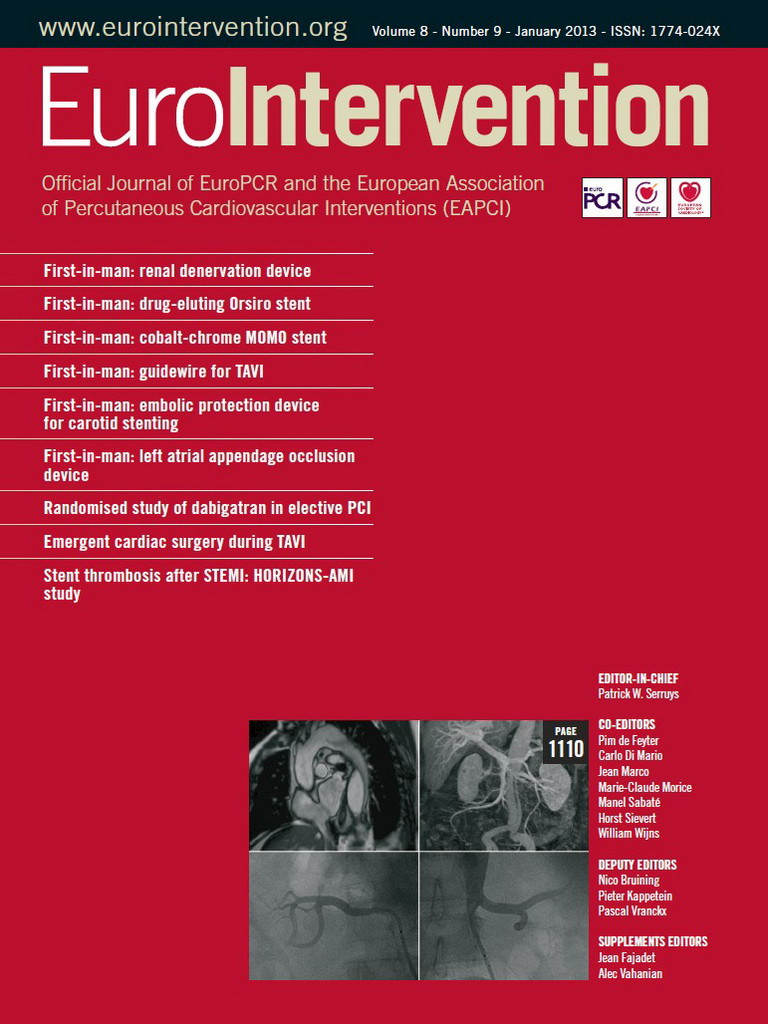Polymer-based drug-eluting stents (DES) have become the treatment of choice for most patients undergoing percutaneous coronary intervention1. Although these stents efficiently reduce rates of restenosis and the need for re-intervention by 70% compared with bare metal stents (BMS), several risks closely related to the metallic cage and polymers have been reported2. For this reason, in recent years the interest in alternative strategies and technologies has been rejuvenated, looking towards promoting rather than inhibiting repair mechanisms following stent implantation. In this clinical scenario the carbon-coated bare metal and sirolimus-eluting cobalt chromium with biodegradable polymer stents have been developed as a feasible alternative to BMS and DES currently available.
In the present issue of EuroIntervention two first-in-man studies are presented concerning the application of new coatings on BMS and DES. In the first report Kesavan shows the results of a first-in-man (N=40) study of a new cobalt-chromium carbon-coated bare metal stent (MOMO stent): at six months follow-up, repeat revascularisation and ischaemia-driven revascularisation were 15 and 7.5%, respectively, with a late lumen loss of 0.54±0.3 mm and without any myocardial infarction, stent thrombosis or cardiac death3.
In the second report of this issue, the first-in-man (FIM) results of a novel drug-eluting (sirolimus) metallic alloy (cobalt-chromium) device with biodegradable polymer (PLLA), encapsulated in a silicon carbide material to minimise the tissue/metal+polymer interaction are presented. At nine months, the late lumen loss was 0.05±0.22 mm, with a composite MACE at one year of 10%, including one cardiac death and two ischaemia-driven target lesion revascularisations4.
Both studies support the feasibility and safety of using BMS or DES with new coatings, with acceptably low late loss and event rates at one year. Although both stents appear to be safe, the results do not give them any additional value as compared to conventional BMS and DES commonly available in daily practice. First-in-man studies usually represent a first step for evaluation of new devices. However, some consideration should be given to what the clinical application of these devices will be. Development of metallic stents that are not drug-coated has, for example, likely reached a plateau as confirmed in the study by Kevasan et al showing a late loss of 0.54 for the MOMO stent which is not much different from the known late loss of a normal metallic stent. For this reason a FIM study of a metallic stent would be of value only in case it represents a randomised comparison with a workhorse metallic stent with a strong clinical endpoint. In the case of metallic drug-eluting stents, a FIM study is probably of more value than for a non-drug-coated metallic stent: use of bioresorbable coatings for drug elution may indeed represent a step forward, potentially reducing any adverse reaction in the arterial wall2. In this case, an imaging technique, such as optical coherence tomography, could confer an enormous additional value to a FIM evaluation, looking at the healing process following stent implantation and bioresorption of the polymer5. After a FIM, a pivotal randomised trial is needed, taking as comparator a last-generation stent in use worldwide6. In the design of such a trial, a patient-oriented endpoint instead of device-oriented endpoint would make it even more interesting and appealing, as would an all-comer design including special clinical situations (e.g., acute myocardial infarction, chronic total occlusion, etc.)7,8.
Use of metallic stents in the percutaneous treatment of ST-elevation myocardial infarction represents, for example, a challenge for the interventional cardiologist due to the high rate of stent thrombosis as well as concerns about the superiority of drug-eluting stent use over bare metal stent use. Previous meta-analyses have shown that STEMI is an independent predictor of stent thrombosis, and first-generation drug-eluting stents seem to provide a better outcome than bare metal stents due to a reduced rate of target lesion revascularisation. Recently the COMFORTABLE-AMI and the EXAMINATION trials have examined the role of second-generation drug-eluting stents in STEMI7,9,10. In particular, the EXAMINATION trial randomised more than 1,500 patients with ST-segment elevation myocardial infarction (STEMI) to BMS or EES7. Although the patient-oriented endpoint was not reduced at one year in the EXAMINATION trial, the rate of target vessel revascularisation and, more interestingly, the rate of stent thrombosis were significantly reduced by the use of EES. In addition, the overall rate of target vessel myocardial infarction in the EES arm was as low as 1.1%. In the report by Hamon et al in the present issue of EuroIntervention, the rate of clinically-driven TVR was higher than that of EXAMINATION (6.7% vs. 3.7%), taking into account that baseline clinical characteristics of the patients included in both studies are completely different (STEMI vs. unstable/stable patients) and, in particular, worse for patients included in the EXAMINATION trial.
As the presence of copolymers confers a certain degree of thrombo-resistance and haemo-compatibility, one can envision that future research might be aimed at demonstrating that stent coatings could be protective against thrombosis, or could provide a good recovery for endothelial function in chronic coronary total occlusions11. For such trials, however, an all-comer design allowing broad inclusion of patients with a large sample size having enough power to demonstrate differences in device-oriented safety endpoints will be needed instead of a FIM.
Lastly, one might reflect on whether we really need a metallic cage for the treatment of thrombotic lesions. Bioresorbable vascular scaffolds appear as a promising alternative, allowing the treated coronary segment to restore vasomotion, pulsatility and likely capping a vulnerable plaque12-15. The ABSORB II trial comparing bioresorbable vascular scaffolds vs. everolimus-eluting stents is currently on-going and will shed light on the percutaneous treatment of stable lesions. However, a dedicated trial in STEMI by the use of a bioresorbable device is a worthy project and will be most likely designed in the near future.
Conflict of interest statement
The authors have no conflicts of interest to declare.

